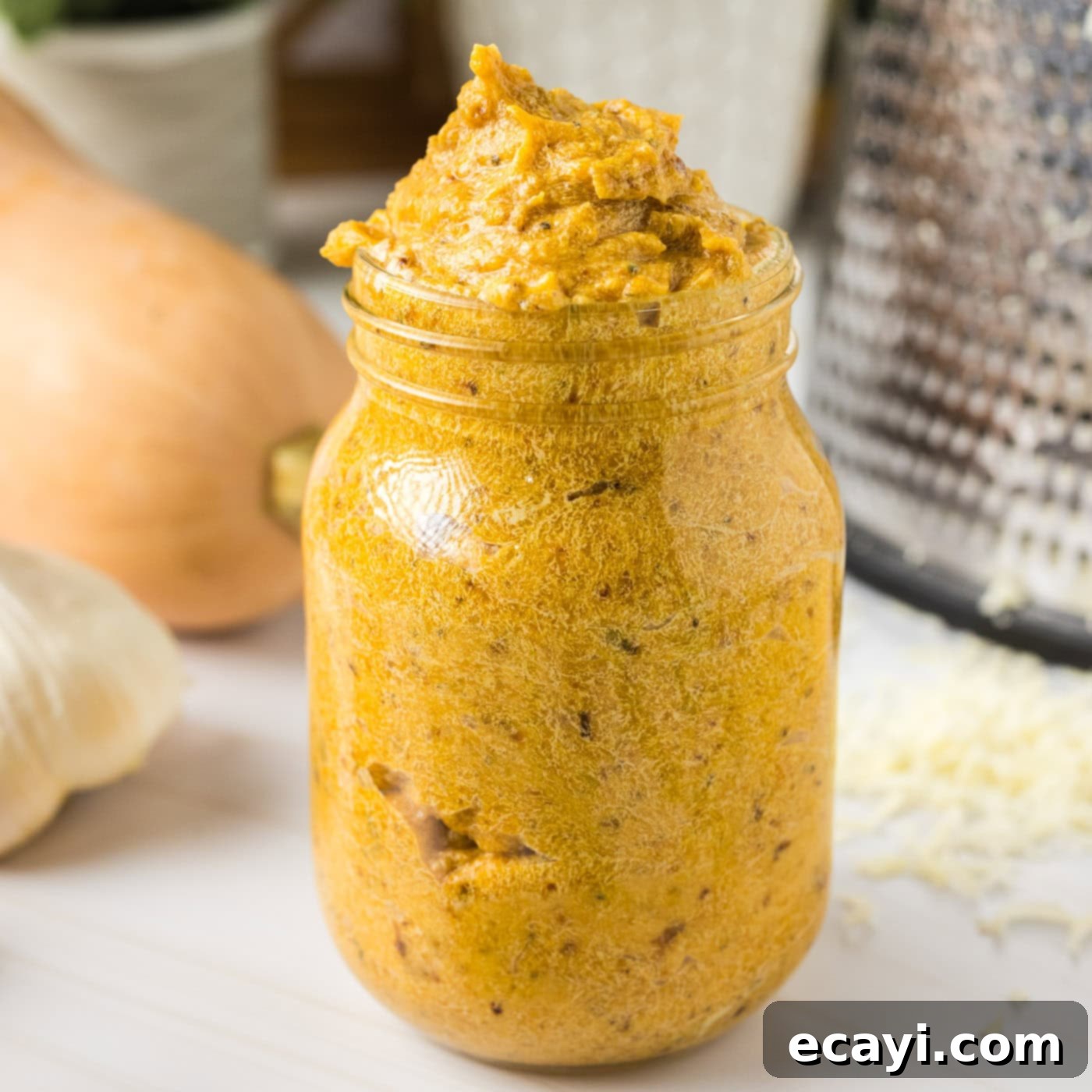Creamy Roasted Butternut Squash Pasta Sauce: Your Ultimate Guide to Easy, Flavorful, and Freezable Homemade Goodness
Welcome to your new favorite autumn and winter comfort food! This incredibly easy butternut squash pasta sauce recipe delivers an ultra-creamy, velvety texture bursting with the rich, aromatic flavors of roasted garlic and sweet shallots. It’s not just a delight for your taste buds; it’s also packed with wholesome goodness. Perfect for a cozy weeknight dinner, this versatile sauce can be prepped ahead, frozen for future meals, or simply tossed over your preferred pasta shape for an instant culinary embrace. Say goodbye to bland dinners and hello to vibrant, seasonal flavor!
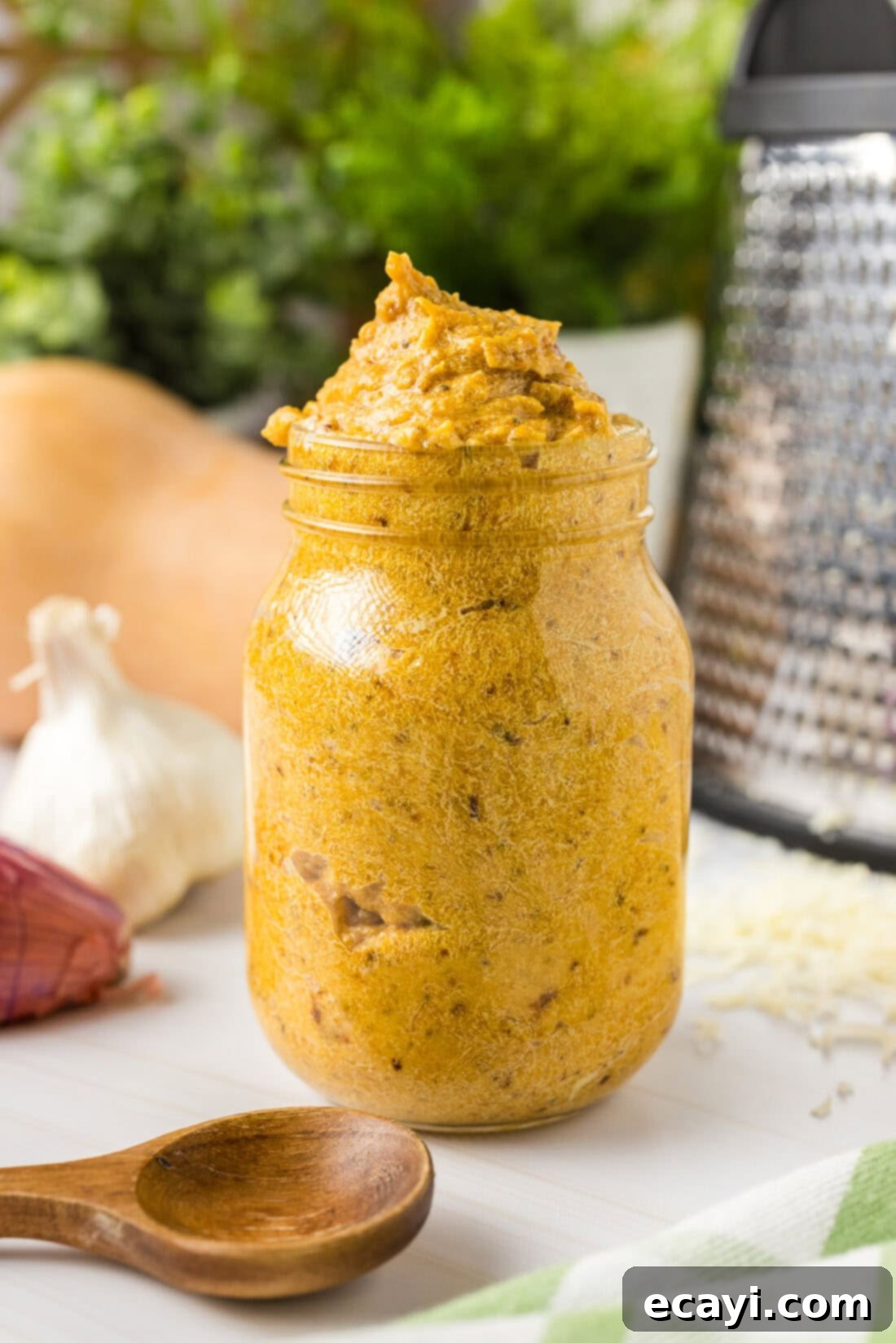
Why This Creamy Butternut Squash Pasta Sauce Recipe is a Must-Try
This roasted butternut squash pasta sauce isn’t just another dinner idea; it’s a game-changer for your recipe repertoire. It truly shines for several reasons, making it a beloved dish for families and foodies alike. First and foremost, its rich, creamy texture, achieved without excessive heavy cream, coats every strand of pasta beautifully. The deep, nutty undertones of the butternut squash perfectly complement the sweet, mellow notes of roasted garlic and shallots, creating a harmonious flavor profile that’s both comforting and sophisticated.
Beyond its incredible taste, this sauce is a nutritional powerhouse. Butternut squash is naturally loaded with vitamins A and C, fiber, and potent antioxidants, all while being remarkably low in calories. This means you can enjoy a hearty, flavorful meal that also contributes to a balanced diet. It offers a wonderful, seasonal departure from your everyday marinara or Alfredo sauces, introducing a unique autumnal warmth to your pasta dishes.
Perhaps one of its most appealing aspects is its surprising ease of preparation. Don’t be intimidated by the idea of roasting squash; the process is straightforward and mostly hands-off. You simply peel, chop, and roast the butternut squash with the shallots, then blend everything with a few other simple ingredients to achieve a luxuriously smooth consistency. You have full control over the thickness – keep it robust for a rich coating or thin it out with extra broth, milk, or half-and-half to suit your preference. There are no strict rules here, just delicious possibilities.
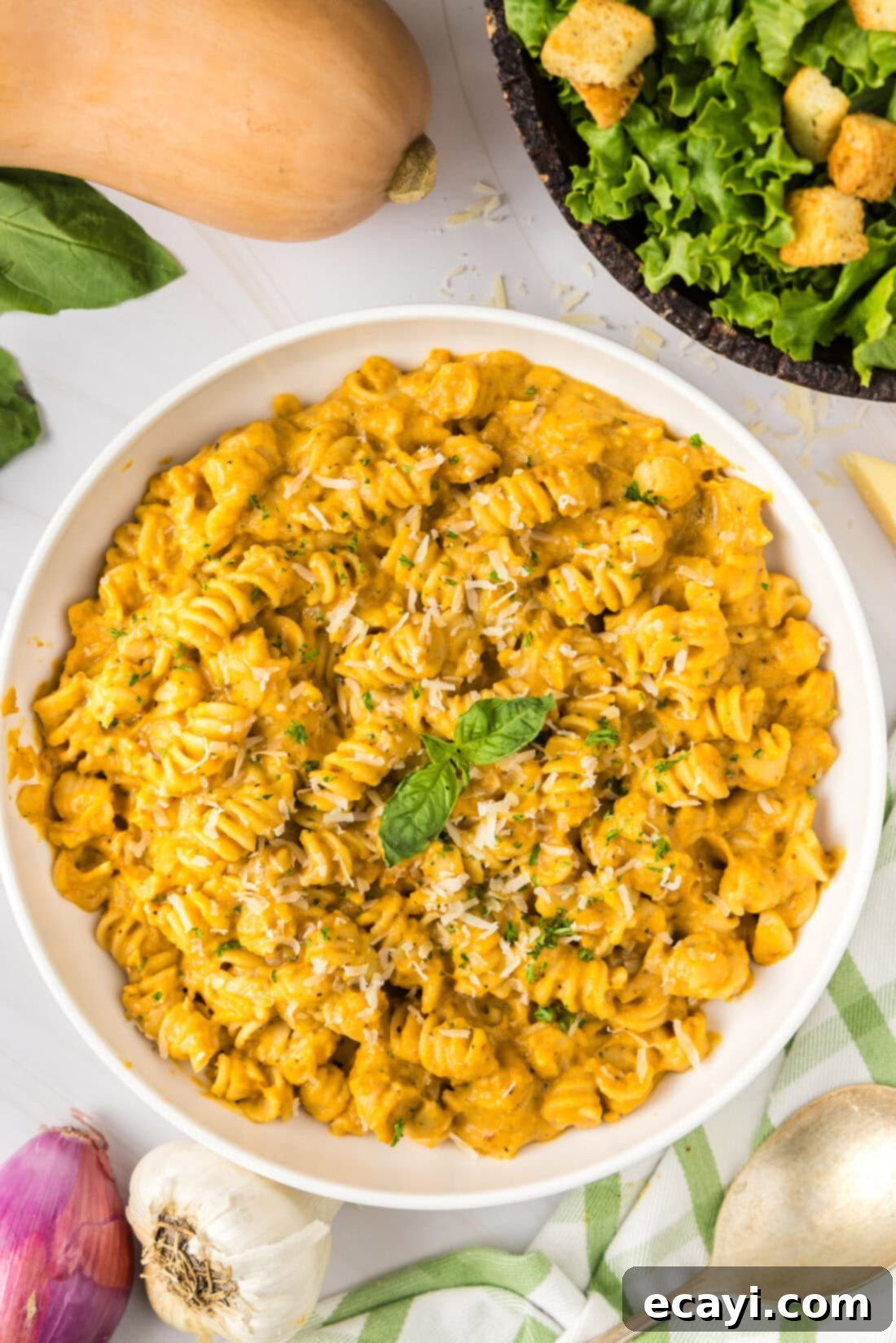
Key Ingredients for Your Homemade Butternut Squash Pasta Sauce
Crafting this delicious butternut squash sauce requires just a handful of fresh, simple ingredients. You’ll find a complete list of measurements, ingredients, and detailed instructions in the printable recipe card located at the bottom of this post. However, let’s dive into some specifics about the components that make this sauce truly special.
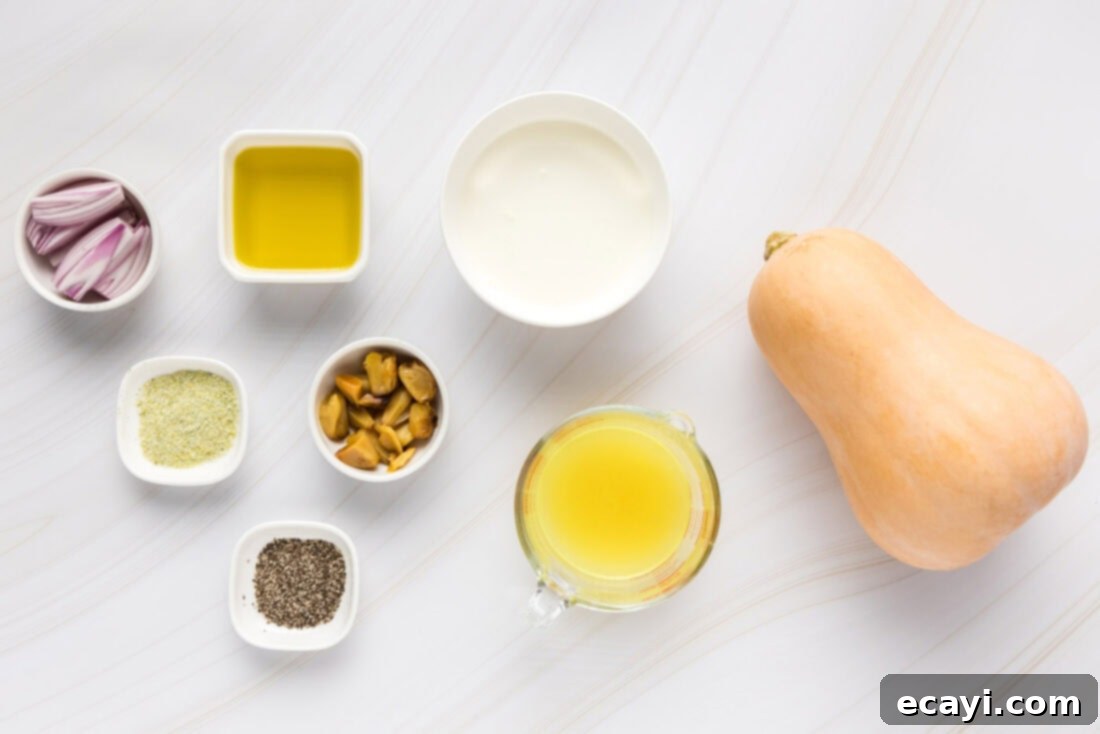
Ingredient Spotlight & Smart Substitutions
Understanding each ingredient’s role and knowing your substitution options can elevate your cooking experience and ensure delicious results every time.
- Butternut Squash: For this recipe, you’ll need approximately 2 pounds of butternut squash. When selecting your squash, look for one with smooth, creamy-tan skin, free from any blemishes, soft spots, or deep gashes. A firm texture indicates freshness. If you’re short on time, many grocery stores offer pre-cut butternut squash, which can significantly speed up your prep. Just be sure to get plain squash, not seasoned.
- Garlic: Our recipe truly shines with the use of roasted garlic. Roasting transforms raw garlic’s pungent bite into a sweet, mellow, and deeply aromatic flavor that perfectly complements the squash. If you don’t have time to roast a whole bulb, you can substitute with about 3 tablespoons of jarred roasted garlic. While fresh garlic can be used in a pinch, roasting is highly recommended for the best flavor profile.
- Shallots: These small, delicate onions offer a milder, sweeter flavor than regular onions, adding a subtle depth without overpowering the squash. They roast beautifully alongside the squash, caramelizing slightly and enhancing the overall complexity of the sauce. If shallots aren’t available, a small amount of finely diced yellow onion can be used as a substitute, though the flavor will be slightly different.
- Olive Oil: A good quality olive oil is essential for roasting the vegetables, helping them to caramelize and become tender. It also contributes to the sauce’s silky texture. We use it for both tossing the squash and coating the shallots. Any neutral-flavored cooking oil like avocado oil could be used, but olive oil adds a lovely Mediterranean note.
- Seasonings (Garlic Salt & Black Pepper): These fundamental seasonings enhance the natural flavors of the squash and shallots. Garlic salt provides a convenient blend of salt and additional garlic essence, while black pepper adds a hint of warmth and spice. Feel free to adjust quantities to your taste. For an extra layer of warmth, consider adding a pinch of ground nutmeg or a sprig of fresh sage or thyme during the roasting process.
- Chicken Broth: This liquid is crucial for achieving the desired consistency and adding savory depth to the sauce. It helps the blending process and can be used to thin the sauce to your preference. For a vegetarian or vegan version, simply swap chicken broth for vegetable broth.
- Half and Half: This ingredient contributes significantly to the sauce’s luxurious creaminess. If you prefer a lighter sauce, you can use milk (dairy or non-dairy like almond or oat milk). For an even richer, more indulgent sauce, heavy cream is an excellent option. For a completely dairy-free alternative, full-fat coconut milk (from a can, not a carton) or a dairy-free cream alternative would work beautifully, adding a subtle richness.
Crafting Your Creamy Butternut Squash Pasta Sauce: Step-by-Step Guide
These step-by-step photos and detailed instructions are designed to help you visualize each stage of making this delicious recipe. For a quick reference and to print the full recipe with precise measurements, simply Jump to Recipe at the bottom of this page.
- Prepare for Roasting: Begin by preheating your oven to a robust 425°F (220°C). This high temperature is key for achieving perfectly caramelized and tender butternut squash.
- Peel and Prep the Squash: Carefully slice both ends off the butternut squash to create flat surfaces. Stand the squash upright on one of these flat ends, then use a sharp chef’s knife or a sturdy vegetable peeler to remove the tough outer skin by running it downwards along the sides.
- Seed and Cube the Squash: Lay the peeled squash on its side, then cut it in half lengthwise. Using a spoon, scoop out all the seeds and fibrous strands from the center cavity. Once cleaned, cut the squash into uniform 2-inch cubes. This ensures even cooking. Transfer the cubes to a large mixing bowl.
- Season the Squash: Add 3 tablespoons of olive oil to the squash cubes in the bowl. Toss them thoroughly to ensure every piece is lightly coated. Then, sprinkle with garlic salt and black pepper, tossing again until the seasoning is evenly distributed. This simple seasoning allows the natural sweetness of the squash to shine.
- Arrange on Baking Sheet: Spread the seasoned butternut squash cubes in a single layer on a large baking sheet. Avoid overcrowding the pan, as this can steam the squash instead of roasting it. Set this aside temporarily.
- Prepare the Shallots: Take your shallot and add it to a small mixing bowl. Pour in the remaining olive oil and toss to coat. Create a small, loose bowl or pouch out of aluminum foil, place the coated shallots inside, and lightly crimp the edges to keep them contained while allowing air circulation for roasting.
- Roast to Perfection: Place the foil bowl of shallots on the same baking sheet as the butternut squash. Transfer the baking sheet to your preheated oven and roast for 30-35 minutes, or until the squash is fork-tender and slightly caramelized at the edges, and the shallots are soft and fragrant.
- Cool Down: Once roasted, carefully remove the baking sheet from the oven. Allow the squash and shallots to cool for at least 10 minutes. This slight cooling period makes them easier to handle and ensures a smoother blend.
- Blend Until Creamy: Transfer the cooled roasted squash, shallots, the roasted garlic bulb, chicken broth, and half of the half-and-half to a mini food chopper or a high-speed blender. Blend until the mixture is completely smooth and free of lumps. The sauce will be quite thick at this stage, which is perfectly normal. You can add more chicken broth or half and half later to achieve your preferred consistency.
- Store for Later: Allow the finished sauce to cool completely before transferring it to an airtight jar or container with a lid. It can be stored in the refrigerator for up to one week, making it excellent for meal prep.
Frequently Asked Questions & Expert Tips for Butternut Squash Sauce
Once your delicious butternut squash pasta sauce has cooled completely, transfer it to an airtight container or a clean jar with a tight-fitting lid. It will keep beautifully in the refrigerator for up to one week. Always ensure it’s fully cooled before refrigerating to maintain freshness and prevent bacterial growth.
Absolutely! This sauce freezes exceptionally well, making it ideal for batch cooking and meal planning. To freeze, first ensure the sauce is completely cool. Then, transfer it to a freezer-safe, airtight container or a heavy-duty, gallon-sized freezer bag. When using a bag, lay it flat for easier storage. Remember to leave about an inch of headspace at the top of the container or bag, as liquids expand when frozen. You can freeze this homemade sauce for up to 3 months.
When you’re ready to use it, thaw the frozen sauce overnight in the refrigerator. To reheat, gently warm it in a skillet over medium-low heat, stirring occasionally. If the sauce is too thick after thawing and reheating, you can easily loosen it to your desired consistency by stirring in a little extra half-and-half, milk (dairy or non-dairy), or chicken/vegetable broth until smooth and creamy.
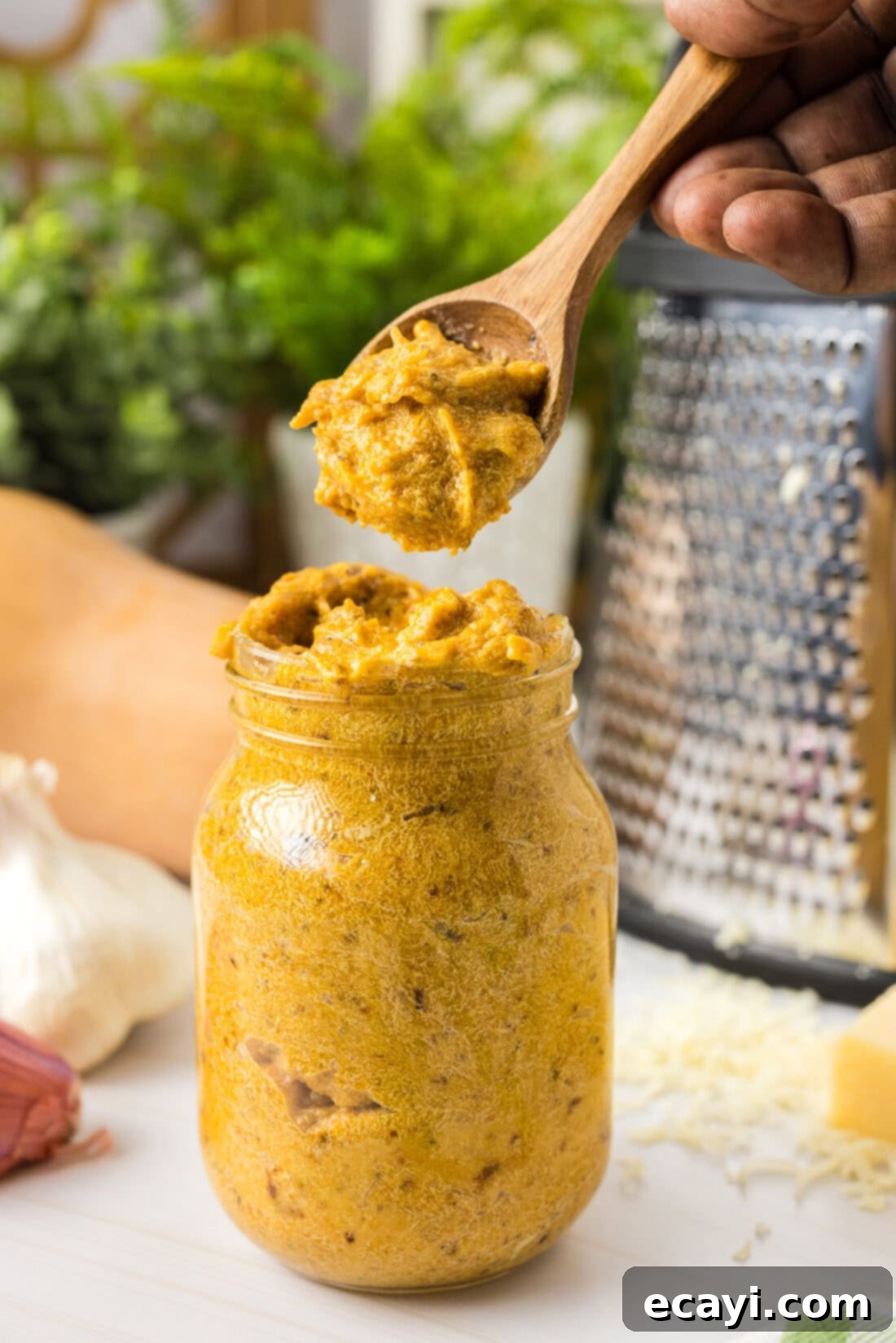
Delightful Serving Suggestions for Your Butternut Squash Sauce
Once your creamy butternut squash pasta sauce is ready, the culinary possibilities are endless! To transform it into a satisfying meal, add the prepared sauce to a large, deep-sided skillet. Gently warm it over medium heat for 3-4 minutes, stirring until it’s heated through and simmering lightly. Then, add your freshly cooked pasta directly to the skillet. Toss everything together until every piece of pasta is beautifully coated in the golden, velvety sauce.
As mentioned earlier, if the sauce appears too thick or you prefer a thinner consistency, you can easily adjust it by stirring in a splash of half-and-half, milk, or broth until it reaches your liking. This sauce pairs wonderfully with a variety of pasta shapes; while rotini or rigatoni are some of our favorites for catching all that rich sauce, it would be equally delicious with penne, fettuccine, or even smaller pasta like orecchiette. Don’t forget to finish your dish with a sprinkle of freshly grated Parmesan cheese, a swirl of extra virgin olive oil, and perhaps some fresh herbs like chopped sage or parsley for a burst of color and aroma. For a complete meal, consider serving it with a crisp green salad and some crusty bread for soaking up every last bit of goodness!
Want to turn this into a full, hearty meal? Check out our dedicated butternut squash pasta recipe which builds upon this incredible sauce base. Enjoy every comforting bite!
Explore More Delicious Squash Recipes
If you’re a fan of the versatile and nutritious squash, you’re in luck! There are so many wonderful ways to enjoy this seasonal vegetable. Here are some of our other favorite squash recipes that you might love:
- Squash Casserole: A comforting and cheesy side dish perfect for any gathering.
- Baked Spaghetti Squash: A lighter, low-carb alternative to pasta, serving as a perfect vehicle for sauces.
- Butternut Squash Mac and Cheese: A creamy, healthier twist on a classic comfort food.
- Slow Cooker Butternut Squash Soup: A warming, effortless soup ideal for chilly days.
I absolutely adore creating and sharing my kitchen adventures with all of you! Remembering to visit daily for new culinary inspiration can be tricky, which is why I offer a convenient newsletter every time a new recipe is published. Simply subscribe today and start receiving your free daily recipes straight to your inbox!
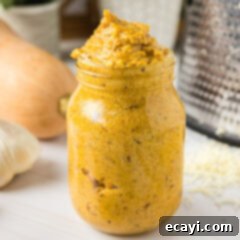
Butternut Squash Pasta Sauce
IMPORTANT – There are often Frequently Asked Questions within the blog post that you may find helpful. Simply scroll back up to read them!
Print It
Pin It
Rate It
Save ItSaved!
Ingredients
- 2 pounds butternut squash, peeled, seeded, and cubed
- 1 medium shallot, peeled and quartered
- 4 Tablespoons olive oil divided
- 1 teaspoon garlic salt
- ½ teaspoon black pepper
- 1 bulb roasted garlic (or 3 tablespoons jarred)
- ½ cup chicken broth (or vegetable broth for vegetarian/vegan)
- ¼ cup half and half (or milk/heavy cream/dairy-free alternative)
Things You’ll Need
-
Chef’s knife
-
Baking sheet
-
Mini food chopper or high-speed blender
Before You Begin
- We highly recommend using our homemade roasted garlic for the best flavor, which yields a sweet and mellow aroma. If using store-bought jarred roasted garlic, measure out 3 tablespoons.
- A garlic bulb is also commonly referred to as a head of garlic. Ensure it is fully roasted until soft and golden before blending.
- For a vegetarian or vegan sauce, substitute chicken broth with vegetable broth and use a dairy-free half-and-half alternative or full-fat coconut milk.
Instructions
-
Preheat your oven to 425°F (220°C).
-
Carefully slice both ends off the butternut squash. Stand the squash upright on a flat end and use a sharp knife or vegetable peeler to remove the tough outer skin.
-
Cut the squash in half lengthwise and scoop out the seeds and fibrous strands. Cut the squash into uniform 2-inch cubes and place them in a large mixing bowl.
-
Add 3 tablespoons of the olive oil to the squash cubes. Toss well to coat thoroughly. Sprinkle with garlic salt and black pepper, then toss again to ensure seasonings are evenly distributed.
-
Spread the seasoned butternut squash cubes in a single layer on a large baking sheet, ensuring not to overcrowd the pan for optimal roasting.
-
Place the peeled and quartered shallot in a small mixing bowl and pour in the remaining olive oil. Gently toss to coat. Create a small foil bowl or pouch and transfer the shallots into it.
-
Place the foil bowl of shallots on the same baking sheet as the squash. Roast in the preheated oven for 30-35 minutes, or until the squash is tender and slightly browned, and the shallots are soft.
-
Remove the baking sheet from the oven and allow the roasted vegetables to cool for 10 minutes. This helps prevent steam buildup when blending.
-
Carefully transfer the cooled squash, shallots, roasted garlic, chicken broth, and half of the half-and-half to your mini food chopper or high-speed blender. Blend until the mixture is completely smooth and creamy. The sauce will naturally be thick at this point.
-
Allow the finished sauce to cool thoroughly before storing. Transfer the sauce to an airtight jar or container with a lid and refrigerate for up to one week.
Expert Tips & FAQs
- To use the pasta sauce, add the desired amount to a large, deep-sided skillet. Warm over medium heat for 3-4 minutes, stirring gently, until heated through. Then, add your cooked pasta and toss to coat. For a looser sauce, feel free to add additional half-and-half, milk, or broth until it reaches your desired consistency.
- Freezing Instructions – To best preserve your homemade sauce, ensure it has cooled completely before freezing. Transfer it to an airtight, freezer-safe container or a gallon-sized freezer bag. If using a container, leave about an inch of space at the top to allow for expansion during freezing. For freezer bags, lay them flat for compact storage. This sauce can be frozen for up to 3 months. To enjoy later, thaw overnight in the refrigerator and reheat gently in a skillet over medium-low heat, adding liquid as needed to achieve perfect creaminess.
- Flavor Boosters: A pinch of grated nutmeg, a dash of white wine, or a tablespoon of nutritional yeast (for a cheesy, dairy-free note) can further enhance the flavor.
- Texture Adjustment: If your sauce is too thick even after adding extra liquid, you can pass it through a fine-mesh sieve for an even silkier texture, though this is usually not necessary with a good blender.
Nutrition
The recipes on this blog are tested with a conventional gas oven and gas stovetop. It’s important to note that some ovens, especially as they age, can cook and bake inconsistently. Using an inexpensive oven thermometer can assure you that your oven is truly heating to the proper temperature. If you use a toaster oven or countertop oven, please keep in mind that they may not distribute heat the same as a conventional full sized oven and you may need to adjust your cooking/baking times. In the case of recipes made with a pressure cooker, air fryer, slow cooker, or other appliance, a link to the appliances we use is listed within each respective recipe. For baking recipes where measurements are given by weight, please note that results may not be the same if cups are used instead, and we can’t guarantee success with that method.
